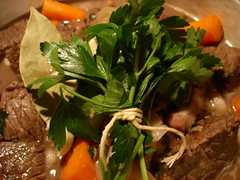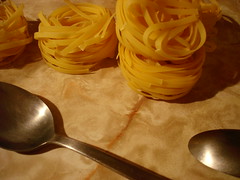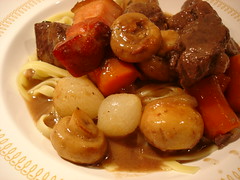Initials B.B.
Now what I didn't tell you yesterday was that that magical iittala casserole came complete with two vouchers redeemable for two classic meals, both French.* When we set about trying to decide what we’d make on Friday we quickly strayed away from those original two options and started to look at recipes for all kinds of things we’d never tried making before but had been dying to, everything from Bollito Misto (that Milanese specialty that dates back to medieval times and, as Patience Gray once wrote, “is one of the best things in northern Italy… to eat in winter”) to Porc Frais au Lait (we've got our eye on Paula Wolfert's version). In the end, for a number of reasons, including time restrictions—because we found out about Michelle’s day off relatively late in the game and then frittered away precious time trying to decide upon “the perfect meal”—we returned to one of the two classic meals we’d started off with.** In the end, we settled on a recipe from our friend Richard Olney that seemed to have everything we were looking for in a casserole-christening meal and that easily fit within our time restraints (one day). In the end, we came back to Boeuf Bourguignon

—or as Olney is careful to name it, Sauté de Boeuf à la Bourguignonne— a dish that had been one of my two “specialties” when I was around 10-12 but that I hadn’t made in decades (a decade of vegetarianism helps to explain why), a dish that had taken on new meaning when we experienced a 72-hour version in New York two years ago at a dinner party. This version was “only” about a 10-hour version, but we’ve always had complete faith in Olney’s impeccable taste, so we weren’t worried in the least.
Like many others out there these days, I suspect, the banality of Boeuf Bourguignon was mostly what led us to look elsewhere for inspiration, but we came back to it hoping to rediscover the real thing and knowing that if we did we’d surely learn some important lessons. As Olney puts it,
Probably the most widely know of all French preparations, Beef Burgundy certainly deserves its reputation—or would if the few details essential to its success were more often respected. The meat must be a gelatinous cut—oxtail…, shank, heel or chuck are all good. The cooking must be slow and even—stringy, dry, cooked-apart meat and an emulsion of indigestible grease in the sauce are the inevitable results of a too-rapid cooking. The sauce must be strained, well skimmed of fat, slowly reduced and purified by skimming. Properly done, the meat will be firm, moist and tender, and the sauce, a deep, warm brown, will have sufficient body to coat all the solid ingredients. There is nothing difficult about its preparation, but there are no shortcuts. [my emphasis]
He then goes on to point out what a crucial building block a properly prepared Sauté de Boeuf à la Bourguignonne can be: “once the principles of one these preparations [Beef Burgundy and its Bourguignon kin, Coq au Vin, Sauté de Veau au Vin Rouge, etc.] is understood, the others not only become automatic knowledge, but a world of new and less traditional possibilities is opened out.” That's all fine and well, but what really convinced me had to do with memories of Beef Burgundies past. Once I started remembering how those carrots and onions turn out when the Beef Burgundy has been finalized, I was absolutely sold on the idea.
Sauté de Boeuf à la Bourguignonne
1 single 3-pound cross section of heel (bone removed)
3 oz. salt pork
2 tbsp finely chopped parsley
1 tsp thyme
2 tbsp olive oil
1 bottle good red Burgundy wine
1/2 lb (2 slices) lean salt side pork
3-4 medium carrots
3 large onions
3 tbsp olive oil
3 level tbsp flour
1/4 cup cognac
1 bay leaf and a bouquet of parsley
2 cloves garlic, crushed and peeled
about 1 cup veal stock, pot-au-feu bouillon, or, lacking either, water
1/2 pound small, firm, unopened mushrooms
salt and pepper
6 tbsp butter
30 small white onions
We didn’t have to cut up the meat ourselves because our local butcher was excited to do it for us (you should have seen him--he was visibly thrilled when we announced we were making a batch of Boeuf Bourguignon). He prepared our beef into about 18 good-sized chunks, ready to be given the B.B. treatment. Once you've got your beef in the right-sized chunks, cut the salt pork into small strips about 1 inch long and 1/4 inch square, then roll them in the chopped parsley mixed with a pinch of the thyme, and force one piece of the salt pork through a slit along the grain of each and every piece of beef. Then let the meat marinate for about 3 hours in a bowl with the olive oil, the rest of the thyme, and the bottle of wine, making sure to toss the pieces of beef well so that they’re thoroughly coated and turning the pieces in the marinade again 2 or 3 times during the soaking period.
Cut the pieces of lean salt pork crosswise into sections measuring slightly over 1/2 inch wide, cover them with cold water, bring to a boil, simmer for 2 or 3 minutes and drain. Peel the carrots and cut them crosswise into 1- or 2-inch lengths. Peel the large onions and cut them into 4-6 pieces each.
Olney points out that all the cooking can be carried out in one large sauteuse, but he recommends using a smaller sauteuse for the initial steps, then transferring everything “to an earthenware or heavy copper or enameled ironware cocotte” for the latter stages of the recipe.
Cook the sections of side pork in the 3 tbsp olive oil over a medium heat, turning (not tossing) each until they are golden and the surfaces lightly crisp. Put them aside and over a lower flame, cook the carrots and the sectioned onions in the same oil for about 20-30 minutes, stirring regularly. The onions should be slightly browned—make sure to watch them closely so that they don’t begin to burn. Remove the vegetables from the pan with a slotted or otherwise perforated spoon, draining them as well as possible of all the fat, and making certain to leave no traces of onion behind because they would immediately burn, leaving an undesirable bitter taste in your sauce.
While the vegetables are cooking, removed the meat from its marinade, drain it well in a colander or large sieve, making sure to collect every last drop of that wonderful liquid, and use paper towel to dry off each piece of meat. Turn the heat up and, again using the same oil, brown the meat on all sides, adding a bit more oil if needed, and salting only after the pieces have been turned once. (Olney points out that you have to be careful with this stage: if the pieces of meat aren’t close enough together, the fat will burn, but if they are overly packed together, their juices will be drawn out rather than sealed in and they will boil rather than sear. Use an extra skillet, or sear them in batches in order to make sure this stage is carried out properly.) Turn the flame down, drain off any excess oil, sprinkle the meat with the flour, and turn the meat 2 or 3 times over the course of 5 or 6 minutes until the flour is lightly browned. (Again, Olney stresses care during this stage: “the eventual color and flavor of the sauce depends, in large part, on the onions, meat and flour being browned to just the right point.") Return the onions and carrots to the pan, stir everything together, and pour in the cognac and the reserved marinade. Stir well and scrape the bottom of the pan with a wooden spoon to loosen and dissolve anything that might have stuck to the pan, transfer the pieces of meat to the cocotte or casserole, pour the liquid and vegetables over, add the parsley and the bay leaf, tied together, the garlic, and enough boiling stock (or water) to cover [we found we barely had to add any liquid at all]. Bring the liquid to a boil and cook, covered, at a lazy simmer, the surface hardly bubbling, preferably in an oven [we found that starting things off at 300° F, then gradually turning the oven down to 250° F worked perfectly], for from 2 1/2 to 3 hours, or until the meat is tender but still firm. Skim the surface fat 2 or 3 times during this period and gently move the pieces of meat around in their sauce ensure that nothing sticks to the bottom.
Interlude 1: This was the period during which we took the time to relax with a glass of wine and have an asparagus appetizer. We’d noticed that the “spring” asparagus had started to be on offer at our local grocery store last week . We’re not sure where they’re coming from (California?), but they’re slender and beautiful and we couldn’t resist. Michelle picked up a bunch and she prepared them according to Olney’s directions found in one of his spring menus, tiède and à la vinaigrette. Steam the asparagus until perfectly tender. Serve them on a plate and issue each diner a bowl in which to prepare their own vinaigrette, instructing them to mix the salt and pepper with the vinegar before adding the olive oil in a thin, steady stream. Each diner then takes one asparagus stalk at a time and dips and rolls the stem in the vinaigrette before eating it. As Olney points out, “Vinaigrette (or, simply, olive oil, salt and pepper) is less an accompanying sauce than an essential seasoning that permits a total appreciation of the asparagus, unadorned.” Sound good? It is. And spring suddenly felt that much closer at hand.
Rinse the mushrooms rapidly, drain them, dry them in paper towels and toss them, salted and peppered, in half the butter, over a high flame, for a couple of minutes, or until they are lightly colored and any superficial moisture has evaporated. Peel the small onions and cook them whole, seasoned, in the remaining butter, preferably in a small pan just large enough to hold them, over low heat, tossing them or turning them from time to time, until yellowed and tender, but not browned.
Remove the pieces of meat and carrot from the sauce (using a spoon, not a fork), discard the parsley and the bay leaf, and pass everything else through a fine sieve. Return the meat and carrots to their pan, add the pieces of browned side pork, the glazed white onions, and the sautéed mushrooms and keep covered while finishing the sauce.
Bring the sauce to a boil and, keeping the saucepan to the side of the flame, simmer and skim regularly for 1/2 hour. [This may seem like a wholly unnecessary step, but as Olney explains, skimming is one of the essentials of French cuisine (not surprisingly, given the amount of butter and other fats that are used). Elsewhere in The French Menu Cookbook, Olney describes the three different types of skimming essential to true French cuisine. These include écumer (to scum)—which, I must say, sounds quite a bit nicer in French—dégraisser (to degrease), and dépouiller. Of these, Olney notes that the first two are “generally understood and respected,” but that the last one—the one used in the making of Boeuf Bourguignon—“is too often misunderstood or merely sidestepped, even by professional cooks, in the mistaken belief that it does not make that much difference.” However, Olney insists, “It makes, among others, the supreme difference between a sauce that is absolutely digestible and one that is not.” This is because any other method winds up throwing the “fat and other impurities back into an emulsion in the sauce,” making the sauce harder on the system, and seriously reducing its flavor.] After half an hour, if the sauce still seems too thin, raise the heat to high and reduce the sauce for another couple of minutes, stirring constantly. [We found that we didn’t have to take such measures. Our sauce was already perfect after the dépouillement phase.] Pour the sauce over the meat and its garnish, return the cocotte or casserole to the oven, and simmer gently for another 20 minutes.
Interlude 2: It was here that we had a touch more wine and some cheese with crackers and baguette slices.
Serve the Sauté de Boeuf à la Bourguignonne in its cocotte or casserole. Olney recommends steamed potatoes as an accompaniment, but we took a page from our friend H’s book and served our Sauté the way she’d served us a Beef Daube once, with egg tagliatelle.

Make sure to have a nice crusty loaf of bread on hand to sop up that wonderful sauce. A green salad is always nice afterwards.
Serves 6 to 8 handsomely.
How did it turn out? Ask yourself, has Richard Olney ever steered you wrong?

This meal was long, involved, even a slight bit finicky, but it was fun, rewarding, and absolutely fantastic, and there's no question that it delivers on everything Olney promises. Just the aroma alone was worth the effort. The fact that we’ve gotten two full meals (with a lighter lunch yet to come) out of it is just icing on the cake.
aj
Richard Olney's The French Menu Cookbook: The Food and Wine of France--Season By Delicious Season--In Beautifully Composed Menus For American Dining and Entertaining By An American Living in Paris and Provence was originally published in 1970. It was republished in 2002 by Ten Speed Press.
* No, these vouchers did not come from iittala. Nor did they come from Les Touilleurs.
** For some bizarre reason, this reminds me of a story Mike Leigh once told about the pre-production for his film Naked. He went into the pre-production knowing he wanted to work with David Thewlis. They’d worked together on Life is Sweet and Leigh was so impressed by Thewlis’ acting that he decided that he wanted to make him central to his next film. He told Thewlis to work up some characters, then come by for a visit, and they’d discuss how to proceed with the project. Thewlis showed up and started to act out the various characters he’d developed, describing their back-stories, their tics, and their idiosyncrasies in some depth in the process. And Thewlis being Thewlis, he ended up spending an entire day there in Leigh’s office and running through some 500 different characters. When he was done, he turned to Leigh and said, “So, Mike, what did you think?” To which Leigh responded, “I liked the first one.”









2 comments:
This sounds fantastic! This dish is one of my favorite things to make, but naturally, Olney's version has way more steps to it than the version I usually turn out. Couple of questions: what's heel? I've never seen this in a butcher shop. Surely not the same as calf's foot. And, also, what's salt-side pork? Many thanks!
Hi Stephanie,
Thanks for reading. The heel is the heel of round, "the part of the hind leg beneath the round," as Olney explains, but oxtail, shank, and chuck also make for a good boeuf bourguignon. Salt side pork is salt pork that's got some lean meat on it--we also use it for our baked beans.
Post a Comment